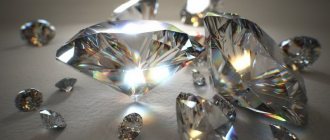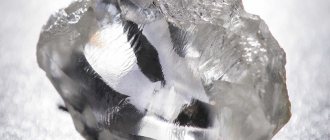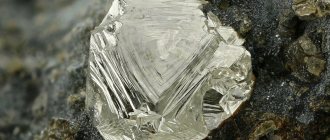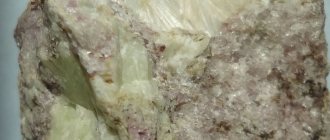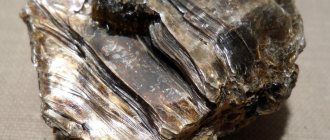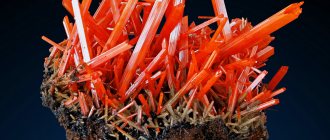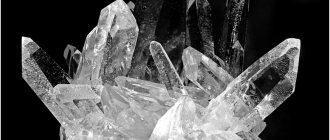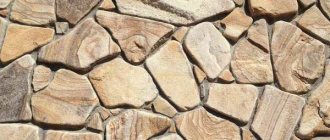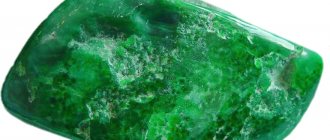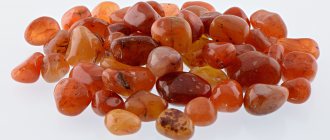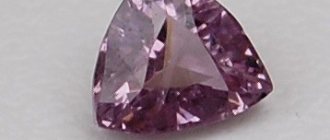Over time, it was the diamond that gained worldwide popularity and demand. A cut stone is called a diamond. Representatives of the fair sex dream that their lover will give them a ring with an elegant and stunning gem. There is still controversy regarding its history, since scientists have not come to a common point of view. One of the most likely theories of the origin of diamond is that the mineral is formed after silicates in the mantle of the earth's crust cool.
Its extraction is carried out in olivine, serpentine and graphite (rocks). True, there is a slight probability of finding it in river or sea pebbles. When volcanic rocks break down, small rocks get trapped there. To find a one-carat diamond, it is necessary to process about 500 tons of ore.
For this reason, the price of diamonds is so high and inaccessible, although their chemical composition is not particularly unique. This stone is the simplest mineral, which contains carbon, as well as minor impurities of substances such as calcium, magnesium and iron. Diamond deposits are located all over the world, with the exception of Antarctica.
Diamond (diamond)
This incredible gemstone is the king of white gemstone jewelry. Diamond is the most popular choice for engagement rings, and they are also the hardest gemstones, scoring 10 out of 10 on the Mohs hardness scale.
They reflect light beautifully and have a unique shine that can mesmerize people. But most likely everyone knows this. We bet you didn't know that diamonds aren't that rare. In fact, there are a couple of semi-precious gemstones that are rarer than diamonds.
White stone diamond
So, if not rarity, what drives a diamond's high price? These are its almost flawless clarity, carat weight and amazing properties of reflecting light with all the colors of the rainbow. Additionally, in addition to the colorless variety, it is possible to find natural diamonds in almost any color.
Colors and types of diamond stone
Precious gems differ depending on their weight (they are small, medium and large) and on the area of use. Physical characteristics have a direct dependence on the color of the stone, which affects its future fate. The following varieties of diamond are known:
- Yater. This stone has white and blue shades;
- River. Unlike yater, it is completely transparent;
- Wisselton tone. A slightly cloudy white mineral;
- Wisselton. Perfect white diamond;
- Top crystal. The stone has a yellow tint, which gives it a dull luster;
- Krystle. The mineral is bright yellow in color;
- Verp light. This diamond is characterized by a brownish tint;
- Cape. It is often confused with crystal. True, the color of the cape is not so deep and rich;
- Light brown. The stone is light brown in color.
Pearl
A fantastic and very popular stone that almost everyone has heard of and which many have seen in person is pearls. Pearl organic precious white stone . This means that it is formed as a result of the vital activity of living organisms.
In this case, such an organism is an oyster. There are four types of cultured pearls: freshwater, South Sea, Tahitian and Akoyan. These pearls grow on oyster farms in different parts of the world.
White gemstone pearl
On the other hand, there are wild pearls that grow in oysters living in the ocean and accidentally discovered by fishermen. Both types of pearls are natural, as both are produced by oysters.
However, you should be extremely careful when wearing pearls, as these stunning white gemstones can be fragile. Take care of them to maintain their fabulous shine.
Application
Not every mined diamond becomes part of a piece of jewelry, but it is still widely used. Therefore, when you look at a photo of a diamond stone, you might think about how many other such stones were not set into jewelry. Diamond dust and small pieces of stones remaining after processing are used in many fields. Naturally, the use of diamonds in industry is expensive, so for these purposes, in the 20th century, a method of creating an artificial material was invented, which involved applying high pressure and temperatures to graphite. True, it will no longer be possible to make jewelry from such a synthetic mineral.
In surgery or mining, diamond dust is used primarily for cutting. In the first case, a scalpel with this addition leaves thin and even cuts. In the second case, for cutting rocks. Diamond chips are also used for cutting other diamonds.
This stone is also used in the construction of various complex devices, reducing the risk of overheating and increasing strength and stability.
Moon rock
One of the most mysterious white gemstones, the moonstone has a unique appearance that has given rise to many legends surrounding it. Due to its unique mineral composition, the stone seems to glow from within.
Pictured is a moonstone
Its moonlit glow along with its feminine appearance makes the jewel one of the best white gemstones for jewelry. It looks great in any setting and has a subtle shine that draws attention to it. However, it is important to know that, like pearls, moonstones are not very hard.
Properties of diamond stone for zodiac signs
This mineral makes Aries even more purposeful and self-sufficient. They believe in their strength and move towards their own goals. To enhance the impact of diamond, representatives of this zodiac sign should buy products with it on the 15th lunar day. It is optimal to wear jewelry on the left side. If the stone comes into contact with the skin of its owner, then its special qualities are doubled.
The Sun and Venus provide the power of the diamond. It is so energetically powerful that it is the most powerful and important mineral. He has the power to influence every person. The main thing is that he is motivated by pure thoughts and sincere actions. True, the properties of the diamond stone are not revealed to such zodiac signs as Capricorn and Pisces. It has a negative impact on them. Because of it, Capricorns and Pisces become overly suspicious and make the wrong choice.
Each zodiac sign needs to settle on a specific diamond color. After all, the right shade is the key to a positive impact on a person. Gems of a yellow tone are suitable for representatives of the air element, especially for people who believe in God. Fire signs should choose red specimens, which is quite logical. Under their influence, the chakras will be cleansed, and astral spirits will be attracted to the owner of the gem.
Blue stones are necessary for representatives of the water element. It is to them that the diamond will reveal its full magical potential. The white mineral has a capricious character. However, all zodiac signs can tame it. The main thing is to maintain balance. To do this, you should not wear the gem very often.
White sapphire
When you think of sapphires, the dreamy deep blue color comes to mind. However, it will come as a surprise to many that sapphires can also be pink or even colorless.
White sapphires are also essentially colorless and closely resemble diamonds. Of all the colorless and white gemstones, sapphires most closely resemble diamonds, especially when they are low carat.
White sapphire
Large white sapphires tend to be somewhat milky and do not have the same clarity as diamonds. However, white sapphire is a very good choice for jewelry as it is a hard and durable gemstone with an amazing appearance.
White or colorless diamond: is there a difference?
Every month, in her personal column on JEWELIRUM, expert gemologist and teacher at the Gemological Center of Moscow State University Yulia Irtyuga examines a current topic related to precious and other stones. In two previous publications, Julia talked about black diamonds, as well as the marketing names of these stones - ice, salt and pepper, and so on. Today the author concludes the topic of “non-canonical” diamonds that can be found on sale with a story about the so-called “white diamonds”.
Screenshot from the website of the “Our Gold” store with an example of the “White Diamond” stone category
Have you ever encountered colorless diamonds being called “white” in stores? Personally, I have heard this often. Therefore, I want to explain in a simple way the difference in these stones.
Let's look at what classic colorless stones are. Let's imagine a glass of ordinary water. The liquid may be completely colorless or slightly tinted. This is roughly what diamonds that are familiar to everyone look like.
Now let's think about what will happen if we pour a large portion of milk into a glass with a small amount of water? The resulting liquid will be very similar in color to a white diamond.
Classic diamonds are transparent. They are cut in such a way as to create from them a certain optical device (give a cut) that can best demonstrate “fire”, brilliance, sparkle for the eye of the observer. White diamonds have a milky, frosty color. These stones are opaque, they will not have a strong play ("fire"), thanks to which the classic "girl's best friend" became famous. If you look at the stone, from the top it will show a distinct milky white color.
This color is obtained due to the high concentration of submicroscopic inclusions that are located in the stone and scatter light. Their nature has not yet been fully studied and, accordingly, is very curious for scientists. The most famous examples of white diamonds were found at the Panna mine in India.
White diamonds are classified as colored diamonds. In other words, they are called "fancy colored".
"White" diamonds. Photo: isradiamond.ru (heart-shaped diamond), leibish.com
Colored diamonds are extremely rare in nature. If compared with colorless ones, the ratio will be 1 to 10,000. Thanks to this, the prices for such amazing diamonds are higher.
I would like to note that white diamonds are unique, created by nature itself. If you suddenly see such a stone in a museum or store window, you know you are lucky, because they are extremely rare.
YULIA IRTYUGA
Expert gemologist with more than ten years of experience. Lecturer at the Gemological Center of Moscow State University named after M.V. Lomonosov. Author of a course on marketing stones and jewelry at the Gemological Academy.
Yulia regularly speaks at international conferences on the topic of precious stones and marketing in the jewelry industry, attends world industry exhibitions, and also goes on expeditions to deposits in different countries, and to date has visited 30 countries with a rich stone and jewelry history.
Yulia Irtyuga shares her observations on her blog on Instagram: @yulia_irtyuga.
All about rough diamonds in the reference section of the portal | Illustrated guide to types of stone cutting | All publications tagged PEBS | All publications tagged HOW IT’S WORKED
Share this article with your friends
Tags:HOW IT'S ARRANGED, PEBBLES
White opal
Also known as milk opal or light opal, this gemstone is incredible. Despite being the most common type of opal, this stone has a unique appearance and amazing luminous properties.
White opal
When opal comes into contact with light, it exhibits a beautiful iridescence and delicate play of colors. White opals look great in earrings or bracelets, as well as necklaces. However, for rings, rings with an opal setting are recommended. Other types of placement expose the stone too much and make it susceptible to scratches.
Healing properties of diamond stone
The value of a diamond is determined not only by its attractiveness and sophistication. It has many healing qualities that have a beneficial effect on the physical and mental state of a person.
Color therapy is a branch of alternative medicine. The treatment method comes down to directing cathode or ultraviolet radiation to the stone. The deep blue color is supposed to cleanse the body.
Diamond water has special properties. If you drink water that contains the mineral for 3 days, it will have a tonic effect. It is saturated with substances that can destroy many microbes. In addition, such water successfully copes with chronic diseases.
Hindu healers often use the healing properties of diamond stone. They are confident that the mineral can cure many diseases. It relieves asthma syndromes, helps remove kidney stones and get rid of infections. It has a beneficial effect on overweight people and speeds up metabolism.
Zircon
It is very important not to confuse this natural gemstone with cubic zirconia, which is a synthetic variety. Zircon is a colorless gemstone with excellent brilliance and good transparency.
Faceted white zircon
They are very similar to diamonds, but much more affordable. This gemstone is capable of reflecting light in a unique way. When wearing zircon jewelry, it can reflect a fiery spark that will enchant and mesmerize anyone.
How to distinguish a natural diamond from a fake one?
Specialists manage to perfectly copy the attractiveness and characteristic features of a diamond. However, with a detailed study, it is possible to distinguish a natural mineral from a fake. First you need to inspect it under the sun's rays. The natural gem sparkles brightly. At this time, two rays are formed. The first one has a direct direction. The second one has a lateral one. The most important feature of a faceted stone is its high degree of refraction.
Often in films there are scenes in which the mineral is used to cut glass, which is quite true. A high-quality natural diamond can not only scratch, but also cut glass.
When purchasing a product with a diamond, you should hold it in your hands for some time. If its surface has become warmer, then it is a fake stone. Of course, the store is unlikely to allow you to use sandpaper to rub the mineral. But this is an effective way to test its strength and naturalness.
White Agate
One of the most diverse gemstones, agate exists in all colors of the rainbow. But its most successful color is white. White agates can range from perfectly colorless to milky opaque white.
Earrings with white agate
This gemstone has a good hardness rating (7 on the Mohs scale), beautiful luster and a stunning appearance when set in gold or silver. It has a distinctive appearance that can offer many options for wearing it.
Precious mineral deposit
In ancient times, diamonds were mined by hand from the ground or river sediments.
According to legend, birds were used to extract gems from deep crevices. To do this, they threw pieces of meat into the gorges, which the eagles hunted for. The stones stuck to the pieces, then people took them from the birds or looked for them in the droppings. In this way they managed to find even large nuggets .
Be sure to see: Properties and purpose of uvarovite
In the mid-19th century, kimberlite pipes were discovered - these are pipe-shaped channels in the earth's crust that were formed during the breakthrough of magma. They are part of ancient volcanoes, the ground part of which has been destroyed. This depression is filled with igneous rock containing diamonds. According to experts, about 90% of all reserves of gems in nature contain kimberlite pipes. They got their name from the village of Kimberley (South Africa), where they first found such a crevice and crystals in it.
The main diamond mining centers are located in the Russian Federation (Sakha Republic), South Africa (Namibia, Botswana, Angola), Brazil (Minas Gerais, Bahia). You can also find gems in Australia, the USA, Canada, and Kazakhstan. Indian diamond mines are almost exhausted.
The world diamond market is led by the three largest in South Africa, ALROSA in the Russian Federation, and Rio Tinto Group in Brazil.
Goshenites
Of all the types of white stones, Goshenite is one of the least known. Regardless, this beautiful gemstone comes from the same family as emeralds. It is usually colorless and not as reflective as diamond. However, it offers high clarity, has a good hardness rating of 8 and looks stunning when paired with any metal.
White Goshenite
Etymology
The most ancient name of the mineral is “farium” - this is what the Indians called it, from whom the diamond showed itself to humanity.
In different languages of Europe, the word has two origins: Latin “adamantem” (English “diamond”, French “diamant”) and Arabic “almas” (Russian “diamond”). In both cases it is translated as “indestructible”, “unshakable”, which emphasizes the main quality of this stone.
All cut diamonds are called brilliants. This word comes from Belgium and it means “shining”, “sparkling”.
Degrees of colorlessness.
What does "colorless" mean in relation to diamonds?
According to the system used by the GIA (Gemological Institute of America), the color of a diamond is graded using letters, which are in turn grouped into color ranges.
Here's a breakdown of the main color ranges and the letter grades contained within each (from highest to lowest quality):
- Colorless: D, E, F
- Almost colorless: G, H, I, J
- Faint light yellow: K to Z
In quality grading, colorless diamonds are those stones that have no visible yellowish tint. Such stones are placed in the colorless range and are given letter grades of D (the highest grade), E or F.
The next best grading range is called near colorless, and includes grades G, H, I, or J. These stones also do not show any sign of color when viewed in isolation, although they may appear slightly darker next to a colorless diamond.
The varieties, which have a letter color classification of K to Z, have some yellowish hues that range in intensity from faint to strong. They are not considered colorless.
Where and how are they formed
There are several theories about how different types of diamonds are formed. The most reasonable and logical of them is the magmatic theory . If you rely on it, then carbon atoms under the influence of high pressure (at least fifty thousand atmospheres) can change the structure of their crystal lattice, forming this wonderful stone. Moreover, its depth is 100 km or more. Subsequently, during volcanic eruptions, diamonds are carried by magma to the surface of the Earth.
The classification of diamonds, which sorts them based on crystal shapes, color index and other properties, identifies the most interesting meteorite types of these stones. It is likely that this type of diamond is of unearthly origin and arose even before the Sun appeared in our Galaxy. There is also evidence that in nature there are crystals that formed on falling meteorites due to the action of enormous pressure and temperature factors on them.
A remarkable fact is that any types of diamonds are nothing more than “close relatives” of graphite, which undergoes crystallization processes in the bowels of the Earth under high pressure and temperature at great depths. When volcanic lava throws up stones already “prepared” by nature, kimberlite pipes are formed: this is the name of all primary diamond deposits.
When a meteorite falls on Earth, the temperature at the moment it hits its surface is 3000°C, and the pressure rises to 100 hPa. Since such extreme conditions are close in numbers to the processes that occur in the depths of our planet, this becomes the real basis for the formation of an impact type of rock, which includes diamond crystals.
Stones that are clearly of extraterrestrial origin have been found in large quantities in the United States - in the same Grand Canyon where a huge meteorite fell 30,000 years ago. There is a similar deposit, which appeared as a result of a meteorite fall, in Yakutia. Such large meteorite craters are called astroblemes and are found in different parts of the Earth: in addition to the USA and Yakutia, a similar deposit in the form of a crater is found in the northern regions of Siberia.
Despite its obvious rarity, diamond is a stone that is very widely distributed. Its deposits can be found everywhere except Antarctica. Read more about how diamonds are mined →
Variety of shapes and sizes
Diamond is a stone with very diverse morphological characteristics. The shape of diamond can be either mono- or polycrystalline, which directly determines the strength indicator. The already mentioned black carbonado has a polycrystalline structure, which was copied by scientists in the laboratory to synthetically produce a super-strong stone. Kimberlite deposits are represented exclusively by those diamonds whose shape is an octahedron or flat-edge.
There are also complex crystals with the original shape of rhombuses or cubes, among which there are specimens that have typical shapes with rounded edges - rhombodecaedroids. They occur when diamonds dissolve under the influence of kimberlite melt. As for the cuboid type of crystals, their formation is ensured by the fibrous growth of diamonds, which occurs according to the normal mechanism. By the way, laboratory-grown diamonds are most often characterized by cuboid crystals, which is one of their differences from natural stones.
The crystals of different diamonds vary: from those that can only be seen under a microscope to very large ones. For example, in 1905, a specimen weighing 0.621 kg, which is 3106 carats, was discovered in South Africa . It was studied for several months and then split into several parts. Rare stones are those whose weight exceeds 15 carats, and the rarest are those whose weight is 100 carats or more. As a rule, they certainly occupy a special place in history, and they are even given names. How to find out how many carats are in a diamond →
